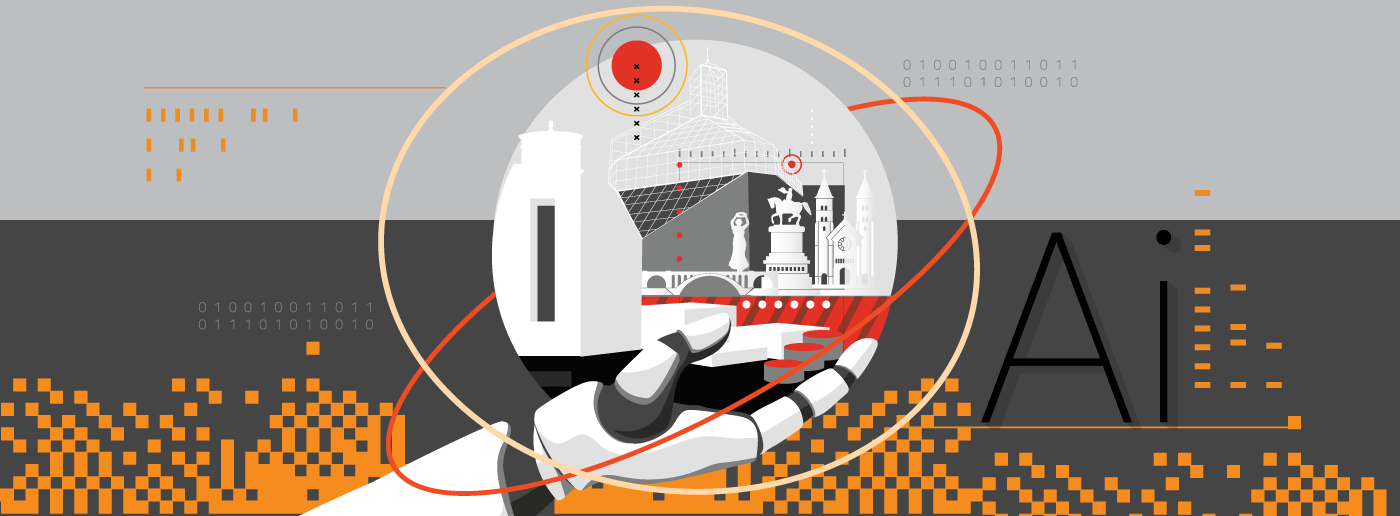Written in collaboration with Amélie Bazin, member of The Blog Team
Once upon a time, Artificial Intelligence (AI) was just a sci-fi daydream—the kind of thing you’d see in movies with flying cars, robot butlers, and computers trying to take over the world. Fast forward to today, and here we are with self-driving cars. AI isn’t only real; it’s your nosy digital roommate that recommends your next binge-watch, finishes your sentences, and might even know your snack cravings before you do.
What used to be wild imagination is now casually running the show—shaping our world, one algorithm at a time, with only a slight risk of world domination. Large companies like Amazon, Google, and Tesla have demonstrated how AI-driven automation and decision-making can deliver significant competitive advantages. But beyond tech giants, is AI truly accessible and transformative for everyday businesses?
Let’s make a comparison. Historically, advanced fertilisers were expensive and available only to wealthy landowners and industrial farms. Over time, innovations made them more affordable, enabling small farmers to benefit from, and contribute to, the agricultural revolution. Similarly, AI was once the exclusive domain of tech giants with vast data centres and deep pockets, however, advances in cloud computing have democratised access to it.
The AI revolution: myth or reality?
First, what exactly is AI? According to IBM, it is ‘technology that enables computers and machines to simulate human learning, comprehension, problem solving, decision making, creativity and autonomy.’
In its early days, AI was primarily used to automate repetitive tasks and boost operational efficiency. But we have since entered a new chapter. Today’s AI systems are taking on complex, cognitive challenges once thought to be uniquely human—from interpreting natural language to generating original content. Fascinating, isn’t it?
On 24 March 2025, the 18th edition of Journée de l’Économie was held at the Luxembourg Chamber of Commerce. This annual conference brings together entrepreneurs, policymakers, economists, and business leaders to discuss pressing economic topics that matter both locally and across Europe.
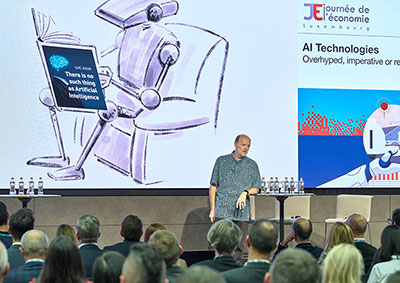 One of the key highlights of the event was the talk by Dr Luc Julia, Chief Scientific Officer at Renault Group, who took the stage to explore a provocative question, ‘GenAI: myth or reality?’. He revealed a surprising historical twist: AI’s roots can be traced back to 1642 with the invention of the Pascaline, the first calculating machine. Not convinced it qualifies as AI? Try multiplying big numbers in your head—then watch how effortlessly AI does it for you.
One of the key highlights of the event was the talk by Dr Luc Julia, Chief Scientific Officer at Renault Group, who took the stage to explore a provocative question, ‘GenAI: myth or reality?’. He revealed a surprising historical twist: AI’s roots can be traced back to 1642 with the invention of the Pascaline, the first calculating machine. Not convinced it qualifies as AI? Try multiplying big numbers in your head—then watch how effortlessly AI does it for you.
With this example, Dr Julia urged the audience to put the today’s AI ‘wave’ into perspective. Rather than calling it a revolution, he suggested we should view it as an evolution. ‘AI technologies are just a bunch of tools,’ he said. ‘They are very useful but for very specific tasks.’
While AI marks a significant step forward in the mathematical methods used to train algorithms—now powered by trillions of data points—the true revolution lies in its accessibility. Thanks to intuitive prompts and user-friendly interfaces, AI is no longer reserved for specialists. It is now within reach for anyone. It changes how we interact with technology, how we work, and how we make decisions. You’re seeing the AI world through a whole new lens, aren’t you?
With that in mind, let’s zoom out and look at how AI is transforming not only Luxembourg’s economy, but also industries across the globe. Which brings us back to the central question: is AI truly transforming the way businesses operate, or is it just another overhyped buzzword?
To explore this, we turn in this blog to the insights shared during a dynamic panel discussion at the Journée de l’Économie, moderated by Gaston Trauffler, Head of Industrial Policy at FEDIL. The panel featured leading voices from the AI field: Maxime Allard, Co-founder of Helical, Véronique Martin-Lang, Chief Engineer AI and Advanced Analytics at The Goodyear Tire & Rubber Company, Marie-Hélène Massard, Deputy General Director at Foyer Group and Stefano Perego, VP International Operations & Global Ops Services at Amazon.
The discussion offered a grounded perspective on how AI technologies are reshaping operations, decision-making, and innovation across sectors. It shed light on the real-world impact of AI, the opportunities it creates, and the critical challenges businesses need to navigate to stay ahead.
AI: a huge booster for productivity
One of AI’s game-changing superpowers is its potential to enhance productivity across various industries by automating repetitive tasks, enhancing decision-making, and streamlining workflows. Let us now take a closer look at each of these areas, illustrated with concrete examples from the panel discussion.
- Integrating AI models into workflows:
AI and integration are transforming industries by connecting systems, processes, and data to drive innovation and efficiency. But how do you actually deploy AI within your company? The answer, according to Maxime Allard from Helical, goes beyond adopting a general-purpose chatbot. It requires identifying specific use cases and developing targeted applications that solve real business problems.
Click here to expand for more details
Mr Allard from Helical shared how his startup aims to help pharmaceutical and biotech companies accelerate their development cycles through AI. By harnessing advanced algorithms, Helical seeks to reduce drug discovery timelines from up to 20 years to under ten.
At the heart of this acceleration is Helical’s open-source platform of bio foundation models, designed to simplify the work of biologists by integrating biological data into their workflows. Businesses across industries can similarly benefit by embedding AI models into their existing systems to potentially accelerate their research or documentation.
A word of caution though: there is no single ‘best’ AI model that can be plugged into a client’s system and expected to work across the board. That’s why Helical’s platform offers access to a diverse range of advanced, pre-trained models—particularly suited to the pharma and biotech sectors. It’s like a one-stop shop where companies can easily integrate and build custom applications on top of existing, pioneering models. These applications are developed by Helical’s in-house team of scientists and made accessible through the platform for easy integration into clients’ workflows.
- Optimising supply chain:
AI is revolutionising manufacturing and logistics by enhancing demand forecasting, inventory management, and efficiency.
Click here to expand for more details
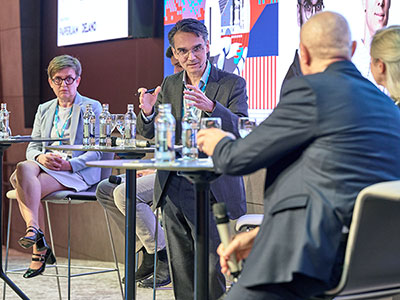
Véronique Martin-Lang shared how Goodyear is harnessing the power of AI, primarily through machine learning and time series analysis to develop a comprehensive digital thread. This thread connects every aspect of their operations—from market analytics and demand planning to manufacturing scheduling.
By deploying these AI-driven solutions, Goodyear is able to produce the right tyres—those needed by consumers and fleets—at the right time. AI enables more accurate demand forecasting and market analysis, helping the company manage inventory more effectively and avoid costly overstock of products with limited demand. The result is improved manufacturing throughput and greater operational efficiency across the board.
Stefano Perego from Amazon highlighted a key industry shift: the move from traditional machine learning and AI to Generative AI (GenAI). This evolution is largely enabled by advancements in computational power, improved sensor technologies, and the ability to process real-time data—particularly in highly automated environments such as computer vision.
In large-scale logistics operations, where automation is critical, GenAI provides new levels of efficiency by optimising processes at a granular level. For instance, in systems similar to Amazon’s—where more than 750,000 robots handle approximately 75% of shipments—AI is used to improve inventory placement, optimise routing, and better manage stock levels, ultimately driving smarter, faster, and more reliable operations.
- Automating repetitive tasks:
AI-powered bots and Robotic Process Automation (RPA) streamline administrative work, reducing human errors and freeing up employees to focus on more complex, valuable tasks. It’s worth noting that AI isn’t replacing humans but rather assisting them in working more reliably and quickly, ultimately improving service and decision-making. AI can also make a real difference in workplace safety.
Click here to expand for more details
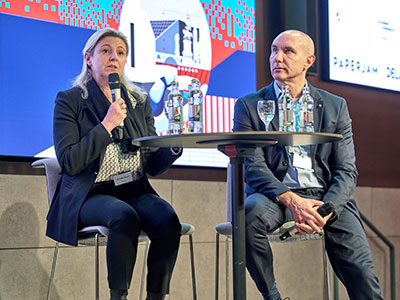 Mr Perego highlighted how AI-enabled automation is transforming Amazon’s vast warehouse operations, which involve hundreds of thousands of employees. By automating repetitive tasks, AI can significantly boost both efficiency and workplace safety. ‘Safety is a topic that can benefit a lot from GenAI,’ he noted.
Mr Perego highlighted how AI-enabled automation is transforming Amazon’s vast warehouse operations, which involve hundreds of thousands of employees. By automating repetitive tasks, AI can significantly boost both efficiency and workplace safety. ‘Safety is a topic that can benefit a lot from GenAI,’ he noted.
One breakthrough he shared was Amazon’s focus on optimising order picking within what is known as the “golden zone,” the area between the shoulders and knees. By designing processes that prioritise this ergonomic range, Amazon ensures that employees make the most efficient and safe movements during millions of daily picks.
The impact has been significant: over the past five years, recordable injuries have decreased by 34%, and lost time incidents have dropped by 64%. These efforts contribute not only to a smarter and safer workplace, but also to improved employee well-being—a key priority in the evolution of large-scale logistics.
Mr Perego also pointed to a key hub of innovation driving this change: a lab in Northwest Italy, where cutting-edge automation is setting new global benchmarks. As he put it, ‘Innovation can be European too.’
At Foyer Group, AI is being used to streamline internal processes —strategically, and with purpose. As Marie-Hélène Massard explained, the focus is not on automating for the sake of it, but on identifying where AI truly adds value and avoiding duplication of effort where it does not. For her, this isn’t about chasing quick wins, but embracing a long-term, evolving commitment. As she aptly put it: ‘You have to start as soon as possible because it’s not a one-day journey, it’s a never-ending journey.’
- Enhanced customer experience:
AI is making customer interactions better, faster, stronger—delivering instant support, smarter solutions, and seamless experiences like never before. Through chatbots and virtual assistants, for instance, businesses can provide around-the-clock support, answer customer queries and reduce wait times. Take Amazon’s Rufus, for example: an AI-powered conversational shopping assistant designed to personalise the shopping experience and guide users through their journey with tailored suggestions.
Click here to expand for more details
In sectors like banking and insurance, AI is streamlining processes such as claims handling and fraud detection, resulting in faster, more efficient service. In that context, Ms Massard emphasised that Foyer Group is committed to embedding AI across its entire value chain—from risk assessment and management to operations. She noted that in customer service, AI is enhancing call centre support, while in sales, it helps advisors offer more relevant, timely guidance.
Claims management, in particular, is evolving rapidly, with AI poised to soon handle the full process. To illustrate this transformation, Ms Massard shared a compelling use case: ‘Imagine a scenario where you’ve had an accident. You take pictures or record a video and send it to us. AI determines whether repairs are needed, and the garage can send video updates, allowing us to assess and approve the repair remotely.’ By using AI to analyse photos and videos, Foyer Group is already making accident claims more seamless—bringing speed, accuracy, and greater convenience to customers.
- Data-driven decision making:
AI-driven data analytics is enabling smarter decision-making by uncovering patterns, predicting outcomes, and guiding strategic actions with greater precision.
Click here to expand for more details
According to Mr Perego, one impactful application lies in damage recognition, where computer vision identifies defects before products are shipped to customers, and another is predictive maintenance, wherein the company uses a huge network of sensors to anticipate when equipment will require maintenance and dispatch a technician before it breaks down. This approach has helped Amazon significantly reduce unplanned downtime, boosting operational efficiency by 69% in recent years.
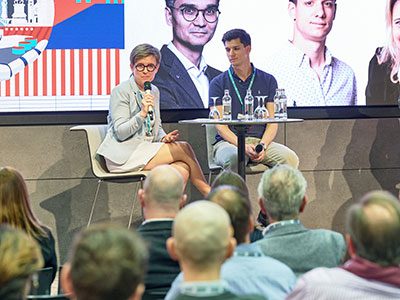 Additionally, AI-powered mapping and routing systems enable real-time adjustments, ensuring greater accuracy and responsiveness in logistics. These advancements are underpinned by Amazon’s in-house foundation models, trained on vast amounts of data to continually refine predictive capabilities.
Additionally, AI-powered mapping and routing systems enable real-time adjustments, ensuring greater accuracy and responsiveness in logistics. These advancements are underpinned by Amazon’s in-house foundation models, trained on vast amounts of data to continually refine predictive capabilities.
Ms Martin-Lang shared that Goodyear’s AI journey began a decade ago, and today, AI-driven solutions are embedded across multiple areas of the business. While manufacturing and demand planning remain key focuses, she also pointed to the transformation of mobility services, particularly in fleet and tyre management.
A standout example is Goodyear’s Tires as a Service solution: an all-inclusive, AI-driven platform that enables real-time monitoring, detects tyre pressure leaks, predicts when tyres need replacing, and ultimately enhances safety while cutting unnecessary costs. By using AI, Goodyear not only boosts fleet efficiency, but also improves its own tyre management—lowering the total cost of ownership and delivering productivity gains across the board.
AI is hiring, not replacing everyone
Contrary to common fears, AI isn’t here to replace humans, but to enhance their work, bringing added value, speed and efficiency. Still, it marks a shift in how we work. This change calls for upskilling, adaptability, and a willingness to collaborate with machines—turning technology into a true partner in progress.
Mr Perego highlighted this point, noting this transformation isn’t just about technology—it’s also reshaping the workforce. Traditional logistics expertise alone is no longer sufficient. Companies now need specialists in areas such as mechatronics, flow management, and emerging technologies. At Amazon, for instance, the rise of AI has created 700 new types of jobs, each requiring new or updated skill sets. To bridge this gap, the company has introduced internal upskilling programmes and new training initiatives to help employees adapt to the demands of AI-driven operations.
Moreover, he reminded us that with industries rapidly adopting advanced technologies, the demand for specialised skills is outpacing supply, making these resources increasingly scarce. As the pace of change quickens, companies are realising the critical need for highly skilled professionals to ensure their operations run smoothly.
However, finding these specialists externally is becoming a challenge. According to the 2025 Luxembourg edition of PwC’s annual Global CEO survey, the lack of skilled workers ranks as the top concern for CEOs in Luxembourg, a point Cécile Liégeois, Clients & Markets Leader at PwC Luxembourg, highlighted during the Journée de l’Économie. This underscores the importance for businesses to prioritise in-house talent development. By investing in training programmes and upskilling initiatives, companies can cultivate the expertise they need internally, ensuring they remain agile and self-sufficient in an ever-evolving landscape.
Ms Martin-Lang shared that six years ago, Goodyear had just six AI professionals in Luxembourg. Today that number has grown to over 20 data scientists, alongside cloud engineers and software developers. She noted that as AI adoption continues to accelerate, the company is upskilling its current employees while attracting new talent with specialised expertise. This strategy underscores Goodyear’s commitment to innovation in an industry where technology was once secondary. As she aptly put it: ‘AI is all over the place today at Goodyear and it’s only growing.’
Building trust in AI
Building trust in AI is crucial, and it starts with awareness and education. As Ms Massard explained, Foyer is committed to making AI understandable and accessible for both employees and clients by clearly explaining how it works and how to use it, without getting too technical.
Through a step-by-step approach and hybrid models where AI operates under human oversight, the company aims to foster a natural learning curve, one that should start as soon as possible. This mutual adaptation between humans and machines helps build confidence and ensures smoother collaboration over time. However, Ms Massard stressed that successfully integrating AI requires the right assets, including infrastructure and talent. For companies not yet prepared in terms of processes and systems, the journey will be longer, making it essential to start early.
Mr Perego also highlighted education’s key role—not only in preparing the professional talent needed to develop AI, but also in helping citizens understand it and benefit from it. By prioritising education and clear communication, companies can ensure that everyone is better equipped to embrace AI’s potential while remaining aware of the risks it may pose.
When smart gets scary: the risks of AI
As AI becomes more integrated into our daily lives, it raises important ethical questions and challenges. How can businesses ensure its responsible development? How can they balance automation with human creativity and empathy?
Often, the risks associated with AI stem less from the technology itself and more from how it is applied. When used improperly or without appropriate oversight, AI can lead to significant ethical and societal issues. For instance, AI-driven decisions like hiring, law enforcement, or healthcare can perpetuate bias if the systems are trained on flawed or incomplete data. There is also the growing threat of AI being used to manipulate, as seen with targeted misinformation campaigns or deepfakes.
Another concern is the use of AI to automate processes in a way that displaces jobs without due consideration for the human impact. Security is also a key risk because AI systems can be vulnerable to hacking or manipulation, potentially leading to unintended or harmful outcomes.
That is why regulations, such as the EU AI Act, are essential: they ensure AI is developed and used responsibly. At the same time, it is important to avoid creating a regulatory environment that stifles innovation and competition. As highlighted in the 2024 Draghi report—authored by former ECB president and Italian Prime Minister Mario Draghi, and focused on European competitiveness and the future of the EU— Europe’s long-term growth and strategic positioning depend on its ability to adopt and harness new technologies.
From Mr Perego’s perspective, as businesses develop AI systems, they need to build on the traditional pillars of responsible development—governance, robustness, and privacy—while also incorporating new principles like fairness, transparency, and explainability. These elements help address the complexity of AI, ensuring that people can understand how these systems work and why they bring value. Without them, there is a risk of slowing down progress.
This is particularly critical for institutions overseeing AI regulations. Mr Perego cautioned that if these concepts aren’t clearly communicated, AI models could be rejected—even though some studies show that users, including employees and work councils, recognise the benefits AI can offer. As he put it: ‘The big risk is that you create an uneven playing field where some countries will go 10,000 miles per hour and Europe is going to stay still.’
AI on the balance sheet: what it takes to build intelligence
AI may be transforming industries, but behind the innovation lies a very real cost. What does it take to build intelligence? For startups like Helical, the answer lies in two key areas: talent and infrastructure. As Mr Allard explained, attracting the right experts to develop and train AI models is a major investment. Equally critical is access to the computing power needed to run them. Without local providers like Meluxina, much of Helical’s progress would have stalled.
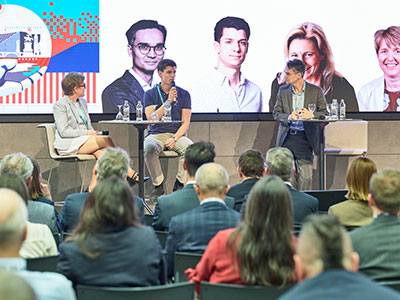 Securing compute capacity is often the first hurdle for startups. Once that’s in place, the challenge becomes deployment—typically through major cloud platforms like AWS, Google Cloud, or Microsoft Azure. In sectors like pharma, where data security and cloud compatibility are essential, choosing the right provider adds further complexity and cost.
Securing compute capacity is often the first hurdle for startups. Once that’s in place, the challenge becomes deployment—typically through major cloud platforms like AWS, Google Cloud, or Microsoft Azure. In sectors like pharma, where data security and cloud compatibility are essential, choosing the right provider adds further complexity and cost.
Ms Massard added that many businesses begin with AI in sandbox environments, which are ideal for experimentation but misleading when it comes to the costs involved in scaling AI. Without clear visibility on long-term costs, CEOs struggle to plan and allocate resources effectively.
Additionally, companies need to rethink internal processes to ensure AI can scale effectively. It’s a steep learning curve, with each new case offering more insight into the broader picture. That’s why strategic partnerships are key, as Ms Massard highlighted.
Smarter machines, smarter choices
To wrap up, AI is undeniably one of the most transformative forces of our time—equal parts thrilling and thought-provoking. From finance and insurance to manufacturing, from startups to tech giants like Google, Amazon, Facebook, and Apple, its potential reaches every corner of the business world.
Yet with great power comes great responsibility. As AI continues to reshape how we live and work, everyone—policymakers, governments, companies, individuals—should reflect on ethics, oversight, investment, and the continued importance of the human touch in an increasingly automated world.
Adopting AI isn’t enough. The real challenge lies in using it wisely: investing in research, nurturing talent, encouraging bold innovation, and fostering a culture that balances ambition with responsibility.
Ultimately, it is our collective judgment that will shape AI’s future. Because, in the end, it isn’t just about making smarter machines—it’s about making smarter choices. If we evolve with purpose and lead with vision, our future won’t just be automated—it will be human-led.
What we think

AI will not replace people in companies; instead, it will create opportunities for new roles and diverse skill sets, shaping a future where human ingenuity and technology work hand in hand.
We often associate AI with powerful, large language models, but in the business world, the real value often comes from small, targeted models that greatly improve and streamline core processes.


